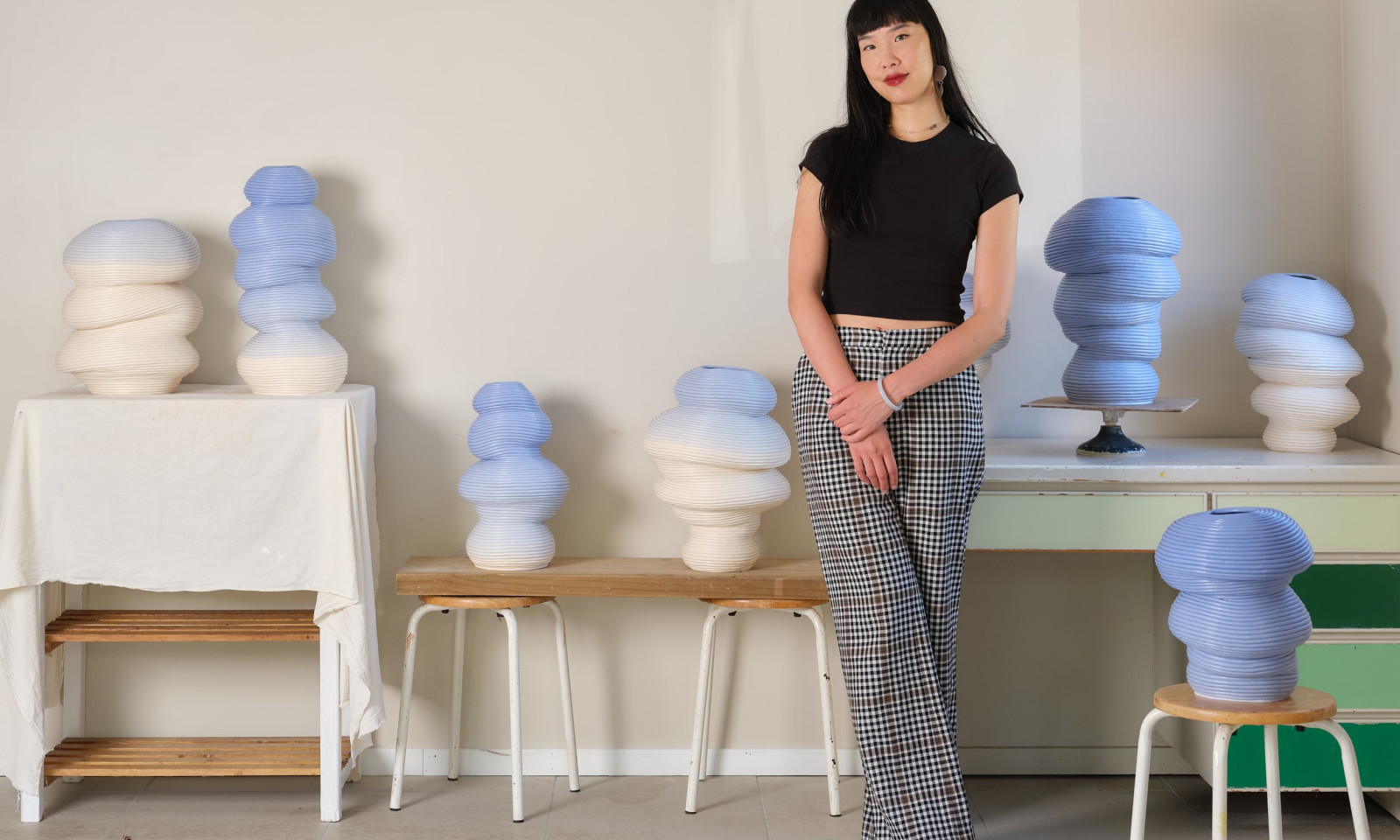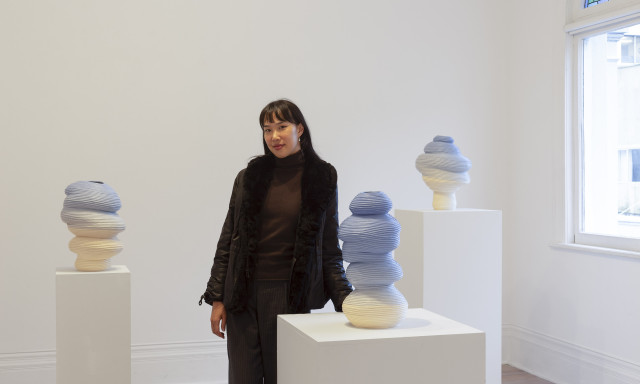
You have lived in Australia, Aotearoa and Paris over the past year. How has your practice evolved in reaction to these different locations and cultural contexts?
Growing up in diaspora, connecting through technology was a familiar part of life. But after twelve years based in Australia, this past year has been the first time in a while that I’ve uprooted again, and I’m re-experiencing the emotional terrain of distance.
In Paris, where I’m building a life from the ground up, my relationship to technology became more heightened - the phone is like a lifeline. That awareness shaped my newer wall-based works, which are more intimate and reflective of how we hold connection in the digital age.
Although I’ve been hand-coiling vessels for ten years in Australia, this was the first time I made them in Aotearoa. I returned to my parents’ home in Auckland over the summer - the longest stretch I’d spent there in over a decade - and worked in their garage, surrounded by familiar sounds and childhood clutter I’ve been long away from. The days were slow, yet passed quickly.
Being in movement between places has sharpened my awareness of absence, proximity, and how relationships are maintained across time zones and technologies - an awareness that naturally bleeds into my practice and one that’s become increasingly familiar to many in the wake of the pandemic.
You have mentioned the influence of Rebecca Solnit’s ‘A Field Guide to Getting Lost’ on this collection of works. Can you please expand on this and her experience of the colour blue?
Rebecca Solnit’s reflections on the colour blue in 'A Field Guide to Getting Lost' have long stayed with me. She writes of blue as the colour of longing — not something that can be possessed, but something that exists in the distance, in the space between you and what you desire. “We treat desire as a problem to be solved,” she writes, “address what desire is for and focus on that something and how to acquire it rather than on the nature and the sensation of desire, though often it is the distance between us and the object of desire that fills the space in between with the blue of longing.”
Someone dear to me is always physically far away - a reality familiar to many of us who live in diaspora. Blue becomes the colour of faraway — a hue that holds the ache of distance, but also a certain beauty in the way it stays, just out of reach. Solnit suggests that with a shift in perspective, longing itself could be cherished: “For something of this longing will, like the blue of distance, only be relocated, not assuaged, by acquisition and arrival.”
This thinking threads through the use of blue in the exhibition — from the hand-coiled ceramic vessels, whose surfaces evoke atmospheric blues, to the small wall-based works bearing phone impressions: the ghost of a touch, a smear, or the desperate press of a finger. These are quiet marks of longing — ways of holding connection when physical closeness isn’t possible.
The blue in these works also gestures to a broader visual lineage — that of blue and white ceramics, which originated in China and travelled across trade routes for centuries. This global history of ceramic exchange is much like the diasporic paths I reflect on in my practice, and how my own cultural identity has been shaped across borders. The blue and whire wares became both precious and everyday, shifting in meaning and use depending on where they landed. In that way, the blue in these works connects personal longing with a broader cultural memory shaped by centuries of movement, migration, and exchange.
You emphasise slowness in your creative process. In a world that values speed and productivity, why is this important to you? How has this theme of time been developed in your new ceramic wall works?
Emphasizing slowness in my creative process is a deliberate choice that challenges the fast-paced demands of contemporary life, where speed, productivity, and mass ready-to-consume production often overshadow depth, reflection, and meaningful engagement. In a world driven by convenience and instant gratification, taking time becomes an act of resistance—one that allows me to truly engage with the materials, the forms, and the conceptual ideas behind my work. Slowness fosters a deeper dialogue with the ceramic medium—its textures, fragility, and transformation through firing—and invites me to embrace unpredictability, including the inevitable breakages and repairs.
My coiled ceramic works are physically slow to create because building them takes time - they must be constructed gradually to allow for structural integrity. The hand coiling process demands patience and careful layering to achieve the desired form and stability.
The theme of time in my new ceramic wall works is inspired by the contemporary experience of distance from loved ones. I press my phone—an iPhone 11 Pro Max, now several years old—directly into the clay, using the very object that connects me to my friends and family. Over these impressions, I add blue abstract marks that resemble finger smudges left on a touchscreen, capturing the tactile traces of presence, intimacy and longing that linger after a message is sent or a call ends, or during a glitchy moment when a face freezes into pixelation and the instinctive touch tries to recover what’s slipping away.
The works also serve as timestamps of a specific era in communication technology, preserving a physical trace of the device through which much of our emotional lives are now filtered. It serves as a tangible record of time spent apart, emphasizing patience and the emotional rhythms that technology both enables and complicates.
Zhu Ohmu's exhibition gradually, then suddenly will show at McLeavey Gallery from Saturday, 5 - Saturday 26, July 2025.
